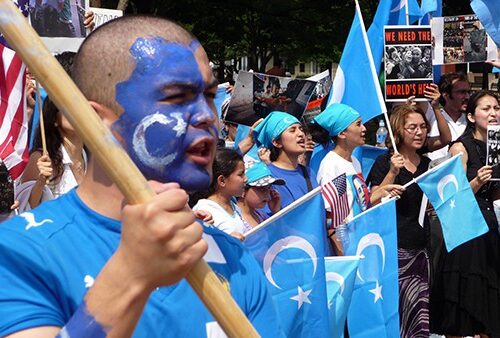Goodbye Pakistan, hello Chinese Turkestan – at least that’s the alternative name for the vast Xinjiang westernmost province of China, home of the Uyghur people who historically had allegiance to Ghengis Khan’s Mongol Empire. But once the Manchu Qing dynasty got control of East Turkestan in the 18th Century it was all over, this area became and remains part of China. Nowadays the population is 60/40 Turk/Han and is an interesting study in China’s approach to colonisation. Economic development here is phenomenal, literally the investment in irrigation and agriculture has made the desert bloom. And the Taklamakan is a massive oil- and coal-rich, desert. The revenues from oil have helped finance the massive agriculturalisation of vast stretches of the Taklamakan. When we were here last in 2005 we were impressed by the sheer scale of the agricultural development but 10 years on its expansion hasn’t stopped.
This southern part of Xinjiang is Uyghur-dominated and the cultural stamp is everywhere we stop – bazaars selling their carpets, traditional knives and handcrafts are in abundance. Any town will have an Uyghur enclave and a Han enclave side by side, but quite separate. It appears peaceful with the two ethnic groups working together at times – such as in the police and on the major projects. But much of the activity is separated along ethnic lines – food and shopping precincts, and living quarters. The reality of course is that the area is a province of China and periodically there are violent outbreaks as the Turkic peoples revolt against the yoke of the Han and press for Xinjiang to be made an independent state. But the protests by the East Turkestan Independence Movement are put down ruthlessly and often very publicly as per a policy of “strike hard”. This seems to keep a lid on effective dissent from the Muslim ethnicities.
The thing that strikes the visitor the most about this region, especially if you have come in from Kyrgyzstan or Pakistan as we have in 2005 and 2014 respectively, is the manifestly higher standard of material living the Turkic population enjoys here. In the countryside the Chinese have constructed housing estates for the farming communities and demolished their traditional mud and brick homes. They have expanded the irrigation infrastructure immensely meaning the farmers get far higher yields than traditionally, and the transport links (road and rail) are as modern as any first world economy. All these investments are in stark contrast to what is available for the people of Pakistan or Kyrgyzstan. The interesting question of course is whether it’s sufficient to overcome the ethnic resentment the Uygurs feel having Han Chinese in effect ruling the roost. The combination of economic development and “strike hard” is the method of ethnic control employed however in Chinese Turkestan, and as one group of Uygurs told us when we discussed this, “what can we do, we are hugely outgunned”.
The command and control nature of China remains very real. The new Han immigrants to this Western province have not volunteered to move. They are sent here to serve the Motherland, that is their duty and it is compulsorily required. One young man we discussed this with had been sent from Inner Mongolia and was expected to marry and settle here when the time came. It seems to us that, just as there is little evidence of an RMA or Environment Court getting in the way of progress, the same goes for demographic engineering – it is the prerogative of the authorities, and those affected comply. “Strike hard” is not an alternative many want to contest.
Having said that, when the decision is made to do something about a negative effect like pollution, China makes short work of making progress. One of the big changes we notice already since our 2005 visit to the West is that the motor scooters and even motor-carts are now mainly fully electric. This cuts out the traffic fumes for sure. The ability to command and control for sure makes short work of these types of “sea change”.


Comments are closed.